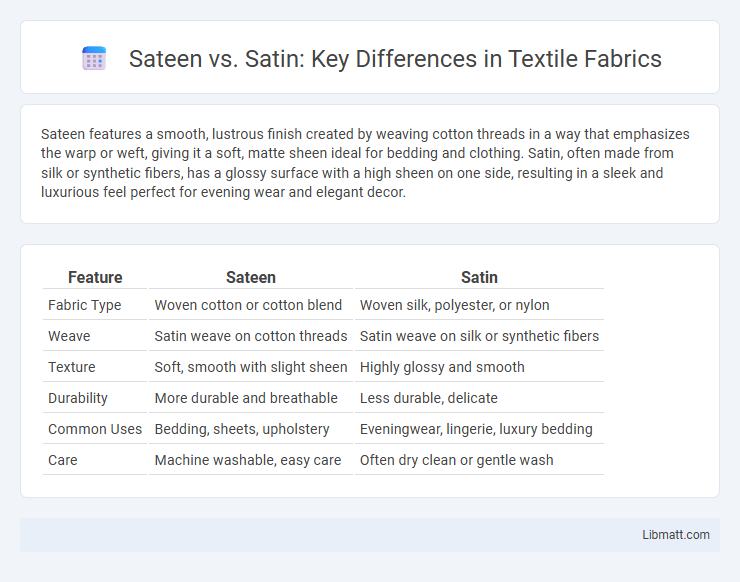Sateen features a smooth, lustrous finish created by weaving cotton threads in a way that emphasizes the warp or weft, giving it a soft, matte sheen ideal for bedding and clothing. Satin, often made from silk or synthetic fibers, has a glossy surface with a high sheen on one side, resulting in a sleek and luxurious feel perfect for evening wear and elegant decor.
Table of Comparison
| Feature | Sateen | Satin |
|---|---|---|
| Fabric Type | Woven cotton or cotton blend | Woven silk, polyester, or nylon |
| Weave | Satin weave on cotton threads | Satin weave on silk or synthetic fibers |
| Texture | Soft, smooth with slight sheen | Highly glossy and smooth |
| Durability | More durable and breathable | Less durable, delicate |
| Common Uses | Bedding, sheets, upholstery | Eveningwear, lingerie, luxury bedding |
| Care | Machine washable, easy care | Often dry clean or gentle wash |
Understanding Sateen and Satin: Key Differences
Sateen features a cotton base with a weave that produces a smooth, lustrous surface, making it breathable and ideal for bedding. Satin typically uses silk or synthetic fibers like polyester, resulting in a glossy finish with a heavier, less breathable texture. Understanding these differences helps you choose the right fabric for comfort, durability, and aesthetic appeal.
Origins and History of Sateen and Satin Fabrics
Sateen fabric, originating in the 20th century, is primarily made from spun cotton fibers woven in a satin weave to mimic the glossy finish of satin but with a softer texture. Satin dates back to the 12th century in China, originally crafted from silk fibers using a weaving technique that creates a smooth, lustrous surface on one side. Both fabrics share a weaving structure but differ in fiber composition and historical use, with satin traditionally linked to luxury silk garments and sateen favored for more accessible, breathable textiles.
Weave Structures: How Sateen and Satin Are Made
Sateen and satin differ primarily in their weave structures, which affect their texture and appearance. Sateen uses a cotton weave with a four-over, one-under pattern, producing a smooth, lustrous surface with a slight sheen ideal for bedding. Satin, traditionally woven from silk or synthetic fibers, employs a similar weave but often with more floating warp yarns, resulting in a high-gloss finish that feels ultra-smooth against Your skin.
Texture and Feel: Comparing Sateen to Satin
Sateen fabric features a smooth, soft texture with a slightly heavier weight, providing a silky feel that drapes well and offers a matte to semi-gloss finish. Satin, known for its glossy, lustrous surface, has a lighter, slick feel that enhances a luxurious and shiny appearance. Your choice between sateen and satin will depend on whether you prefer a subtle sheen with a cozy touch or a high-gloss, slippery texture.
Durability and Longevity: Which Fabric Lasts Longer?
Sateen fabric, woven with a cotton base, offers greater durability and longevity compared to satin, which is made from silk or synthetic fibers prone to delicate wear and tear. Your bedding or garments made from sateen can withstand frequent washing and everyday use without losing their luster or softness. Choosing sateen ensures a longer-lasting investment due to its robust fiber structure and resistance to snags and fraying.
Appearance and Sheen: Sateen vs Satin Finish
Sateen fabric offers a smooth, matte finish with a subtle sheen that reflects light softly, giving your bedding a warm and cozy appearance. Satin, by contrast, features a glossy, highly reflective surface that creates a luxurious and shiny look often associated with elegance and glamour. Both finishes enhance texture differently, with sateen providing a more understated luster and satin delivering vibrant brilliance.
Common Uses: Where Sateen and Satin Excel
Sateen is commonly used for bedding and loungewear due to its soft, matte finish and breathability, making it ideal for comfortable, everyday fabrics. Satin excels in evening wear and formal attire because of its glossy, smooth surface that adds elegance and a luxurious feel. Your choice depends on whether you prioritize comfort and durability with sateen or the lustrous appearance of satin for special occasions.
Care and Maintenance: Keeping Your Sateen and Satin Fresh
Sateen and satin require distinct care to maintain their smooth textures and vibrant appearances. You should wash sateen with cold water on a gentle cycle and avoid high heat to prevent shrinking, while satin demands hand washing or dry cleaning to preserve its delicate finish and prevent snagging. Proper care ensures your sateen and satin fabrics stay fresh and retain their luxurious feel over time.
Cost Comparison: Affordability of Sateen vs Satin
Sateen fabric generally offers greater affordability compared to satin due to its cotton-based composition, making it an economical choice for bedding and apparel. Satin, often made from silk or synthetic fibers like polyester, tends to be more expensive because of its luxurious texture and production process. Consumers seeking budget-friendly yet smooth and lustrous textiles typically prefer sateen for its cost-effective balance between quality and price.
Sateen or Satin: Which Is Right for You?
Sateen and satin both offer smooth, glossy finishes, but sateen is made from cotton with a softer, more breathable feel, while satin is typically woven from silk or synthetic fibers, providing a more luxurious and shiny appearance. Your choice depends on your priorities: sateen suits those seeking comfort and durability for bedding, whereas satin is ideal for elegant, delicate clothing or bedding with a high sheen. Understanding these differences helps you select the perfect fabric to match your style and comfort needs.
Sateen vs Satin Infographic

 libmatt.com
libmatt.com